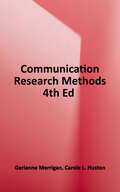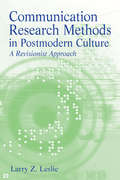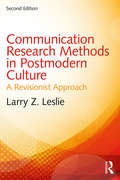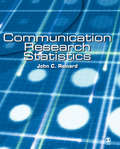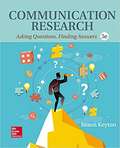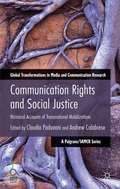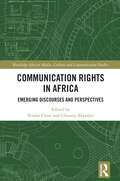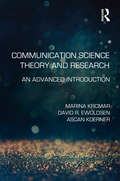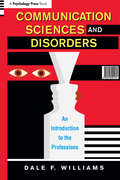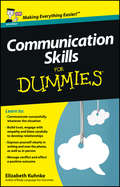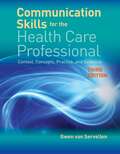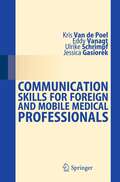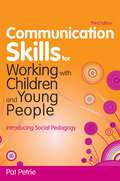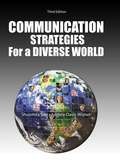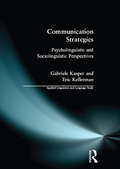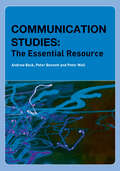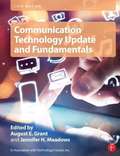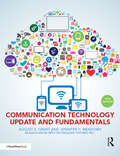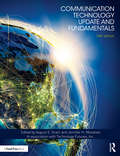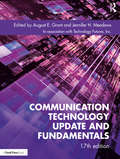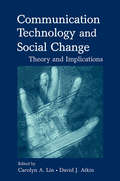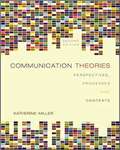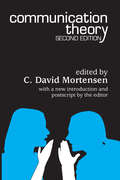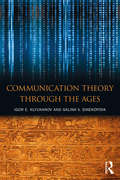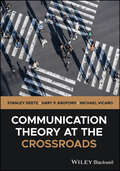- Table View
- List View
Communication Research Methods
by Gerianne Merrigan Carole L. HustonIdeal for research methods courses covering multiple methodologies, Communication Research Methods is the only text that uses a research-as-argument approach to help students not only become more effective researchers, but more insightful consumers of research. Merrigan and Huston treat communication research comprehensively, discussing a broad range of traditional and contemporary methods and considering ethics in designing, conducting, and reporting research. NEW TO THIS EDITION The claims, data, and warrants chapters found in prior editions have been replaced with two new chapters that contextualise research arguments for quantitative social science (Ch. 4) and interpretive/critical research (Ch.11)A new chapter on interviews and focus groups (Ch. 12) will improve students' abilities to conduct interviews and code evidence based on repetition, recurrence, and forcefulness The ethics chapter (Ch. 3) now includes links to the ethical codes of conduct for 10 professional associations relevant to communication researchers in academia and industry Conversation Analysis (Ch. 10) and Discourse Analysis (Ch. 14), have been separated to more clearly represent the paradigmatic differences in those ways of studying language-in-use The chapter titles for all chapters in Parts II and III have been extended to help students more quickly compare those methods, and the text has been reorganised to match the first edition's order of paradigms All chapters include updated examples and more links to industry research. KEY FEATURES Each chapter begins with a short, reader-friendly introduction and student learning outcomes entitled 'What Will You Get from this Chapter? 'Shows students how research skills will matter in their roles at work, as consumers, parents, and voters, in healthcare and community contexts during school and after graduation Highlights the role of different methodologies for making different types of research arguments. This title is available as an eBook. Visit Vital Source for more information or to purchase.
Communication Research Methods in Postmodern Culture
by Larry Z LeslieCommunication Research Methods in Postmodern Culture explores communication research from a postmodern perspective while retaining key qualitative and quantitative research methods. The author uses easy-to-understand language to incorporate new research methods inspired by contemporary culture and includes review questions and suggested activities designed to help readers understand and master communication research. The blend of new and traditional methods creates a book appropriate to the study of communication in an increasingly complex cultural environment.
Communication Research Methods in Postmodern Culture: A Revisionist Approach
by Larry Z. LeslieThe second edition of Communication Research Methods in Postmodern Culture continues to explore research from a postmodern perspective. Typical qualitative and quantitative research methods are adjusted to fit the needs of contemporary culture. Each chapter is updated with new information and fresh examples. Included in the second edition is a new chapter on Internet and social media research. The author uses straightforward and easy-to-understand language. Both individual and group projects are among the suggested activities. This book is important for the study of communication in a changing political, social, economic, and technological environment.
Communication Research Statistics
by John C. ReinardWhile most books on statistics seem to be written as though targeting other statistics professors, John Reinard's Communication Research Statistics is especially impressive because it is clearly intended for the student reader, filled with unusually clear explanations and with illustrations on the use of SPSS. I enjoyed reading this lucid, student-friendly book and expect students will benefit enormously from its content and presentation. Well done!" --John C. Pollock, The College of New JerseyWritten in an accessible style using straightforward and direct language, Communication Research Statistics guides students through the statistics actually used in most empirical research undertaken in communication studies. This introductory textbook is the only work in communication that includes details on statistical analysis of data with a full set of data analysis instructions based on SPSS 12 and Excel XP.
Communication Research: Asking Questions, Finding Answers
by Joann KeytonCommunication Research: Asking Questions, Finding Answers covers basic research issues and processes, both quantitative and qualitative, appropriate for communication students with little or no previous research methods experience. The text's guiding principle is that methodological choices are made from one's research questions or hypotheses. This avoids the pitfall in which students learn one methodology or one methodological skill and then force that method to answer all types of questions. Instead of working with one methodology to answer all types of questions, students come away understanding a variety of methods and how to apply them appropriately.
Communication Rights and Social Justice
by Claudia Padovani Andrew CalabresePlacing struggles for communication rights within the broader context of human rights struggles in the twentieth and twenty-first centuries, this broad-based collection offers a rich range of illustrations of national, regional and global struggles to define communication rights as essential to human needs and happiness.
Communication Rights in Africa: Emerging Discourses and Perspectives (Routledge African Media, Culture and Communication Studies)
by Tendai Chari Ufuoma AkpojiviThis ground-breaking volume examines enduring and emerging discourses around communication rights in Africa, arguing that they should be considered an integral component of the human rights discourse in Africa. Drawing on a broad range of case studies across the continent, the volume considers what constitutes communication rights in Africa, who should protect them, against whom, and how communication rights relate to broader human rights. While the case studies highlight the variation in communicative rights experiences between countries, they also coalesce around common tropes and practices for the implementation and expression of communication rights. Deploying a variety of innovative theoretical and methodological approaches, the chapters scrutinise different facets of communication rights in the context of both offline and digital communication realities. The contributions provide illuminating accounts on language rights, digital exclusion, digital activism, citizen journalism, media regulation and censorship, protection of intellectual property rights, politics of mobile data, and politicisation of social media. This is the first collection to consider communication in Africa using a rights-based lens. The book will appeal to researchers, academics, communication activists, and media practitioners at all levels in the fields of media studies, journalism, human rights, political science, public policy, as well as general readers who are keen to know about the status of communication rights in Africa.
Communication Science Theory and Research: An Advanced Introduction
by David R. Ewoldsen Marina Krcmar Ascan KoernerThis volume provides a graduate-level introduction to communication science, including theory and scholarship for masters and PhD students as well as practicing scholars. The work defines communication, reviews its history, and provides a broad look at how communication research is conducted. It also includes chapters reviewing the most frequently addressed topics in communication science. This book presents an overview of theory in general and of communication theory in particular, while offering a broad look at topics in communication that promote understanding of the key issues in communication science for students and scholars new to communication research. The book takes a predominantly "communication science" approach but also situates this approach in the broader field of communication, and addresses how communication science is related to and different from such approaches as critical and cultural studies and rhetoric. As an overview of communication science that will serve as a reference work for scholars as well as a text for the introduction to communication graduate studies course, this volume is an essential resource for understanding and conducting scholarship in the communication discipline.
Communication Sciences and Disorders: An Introduction to the Professions
by Dale F. WilliamsFew activities can match the complexity of human communication. Given its intricacy, it is understandable that the process will not always work properly. When it doesn't, the effects can be devastating, given how much of everyday life depends on communicating with one another. Despite its importance, however, much is still unclear about how we turn thoughts into language and then speech. Debates rage over various components of the communication system. Myths abound, most based on nothing more than speculation and misinformation. It all makes for a fascinating area of study and practice, particularly when considering the importance of the topic. This book provides readers with the basics of human communication without shying away from the controversies. Dale F. Williams, Ph.D. utilizes a panel of internationally recognized experts in all areas of the field to clearly explain normal communication as well as disorders of speech, language, hearing, and swallowing. Topics that overlap all disorders—diagnosis, treatment, research, ethics, work settings, and multicultural issues—are also covered in a reader-friendly style. In addition to the relevant information on human communication, the book also includes first-hand accounts of both people with disorders and those who work with them. Discussion questions are posed to help readers explore the gray areas and additional readings are described for those wishing to research specific topics. In these ways, readers are provided with information that truly helps them to understand communication sciences and disorders from a variety of perspectives. Communication Sciences and Disorders: An Introduction to the Professions is essential reading for anyone contemplating a career in speech-language pathology or audiology. In addition, the clear and entertaining writing style makes the field, in all its complexity, accessible to anyone with even a passing interest in the process of human communication.
Communication Skills For Dummies
by Elizabeth KuhnkeThe key to perfecting your communication strategy Great communication skills can make all the difference in your personal and professional life, and expert author Elizabeth Kuhnke shares with you her top tips for successful communication in any situation. Packed with advice on active listening, building rapport with people, verbal and non-verbal communication, communicating using modern technology, and lots more, Communication Skills For Dummies is a comprehensive communication resource no professional should be without! Get ahead in the workplace Use effective communication skills to secure that new job offer Convince friends and family to support you on a new venture Utilising a core of simple skills, Communication Skills For Dummies will help you shine—in no time!
Communication Skills For The Health Care Professional Context, Concepts, Practice, And Evidence
by Gwen Van ServellenCommunication Skills for the Health Care Professional, Third Edition is a comprehensive guide to improving patient outcomes through relationship building and the use of information technology to foster communication between patients, families, and health providers. The author examines the context for communication in an evolving health care system and provides the foundations for understanding human and therapeutic communication. Readers will learn critical competencies to ensure quality, patient-centered care as well as skills to manage communication across relevant constituencies. The book also touches on solutions for transforming health care by changing patient behavior and systems of care. Designed for undergraduate students across the health professions, this text provides caregivers with basic communication knowledge and skills and is an invaluable resource for those in administrative functions as well. New & Key Features of the 3rd Edition: Covers principles, concepts, skills, and evidence critical to a broad-base, health professional curricula Teaches communication skills one at a time allowing for contiguous mastery across a set of therapeutic interventions Offers two new chapters that explore advances in health information technology and provide problems on access to and availability of healthcare Includes an extensive glossary of terms and list of references including websites and resources available to enhance student learning
Communication Skills for Foreign and Mobile Medical Professionals
by Ulrike Schrimpf Eddy Vanagt Jessica Gasiorek Kris Van PoelAround the world, the number of internationally mobile medical professionals is steadily increasing, posing potential difficulties for the good communication with patients and colleagues that is vital to satisfactory outcomes and personal professional success. Communication Skills for Foreign and Mobile Medical Professionals is an evidence-based communication resource book designed for all medical professionals who work in foreign countries, cultures, and languages. It offers a wealth of insights into doctor-patient communication, structured around the different phases of the consultation. The proposed strategies and tips will raise the reader's awareness of important recurring issues in face-to-face interactions and improve his or her ability to deal with them effectively. Common misunderstandings between doctors and patients with a different cultural/linguistic background are discussed in depth. Throughout, the emphasis is on patient-oriented medicine. The modular structure of the book will ensure quick and easy retrieval of information. Communication Skills for Foreign and Mobile Medical Professionals will be of benefit to a wide range of medical professionals, from senior nursing staff through to heads of department, in multilingual or intercultural contexts. It will also be of value to human resource managers, language trainers, and cultural mediators.
Communication Skills for Working with Children and Young People
by Pat PetrieFor those working with children, effective communication is a crucial part of building relationships and encouraging children's emotional and intellectual development. This practical guide identifies the child and their relationship with the adult as the basis upon which real communication can be made. Topics covered include non-verbal communication, attentive listening, empathy, the part played by questions, working constructively with conflict and criticism, and communicating in groups. It also draws on the innovative ideas found in social pedagogic theory and practice, such as communicating with your head, hands and heart and how to differentiate between the personal, the professional and the private in your interactions. The book contains exercises, topics for personal reflection or group discussion, and suggestions for observations. This will be an excellent source of advice and ideas for all those in the children's workforce including early years professionals, teachers, social workers, counsellors and practitioners working with children in care, including foster carers.
Communication Strategies In A Diverse World
by Angela Wizner Shusmita SenCommunication Strategies in a Diverse World
Communication Strategies: Psycholinguistic and Sociolinguistic Perspectives (Applied Linguistics and Language Study)
by Gabriele Kasper Eric KellermanThis book examines the topic of communication strategies, the ways in which people seek to express themselves or understand what someone else is saying or writing. Typically, the term has referred to the strategies that non-native speakers use to address the linguistic and pragmatic problems encountered in interactions with native and non-native speakers of the language in question.Studies adopting a psycholinguistic perspective are well represented and updated in this volume. Other chapters re-examine communication strategies from a sociolinguistic perspective, exploring the strategies non-native speakers and their conversational partners use to create shared meanings in ongoing discourse. These studies reveal how communication strategies can serve to construct participants' identities and social relationships. Finally, the book incorporates a number of chapters which cover strategy-like behaviour in other related areas, such as language pathology, child bilingualism, normal native adult interaction, and mother tongue education. These studies add fresh dimensions to the study of communication strategies, showing how the concept can usefully be extended beyond the realm of second language acquisition and use, and pointing out the commonalities in many domains of language behaviour.
Communication Studies: The Essential Resource (Essentials)
by Peter Bennett Peter Wall Andrew BeckThis book brings together a huge range of material including academic articles, film scripts and interplanetary messages adrift on space probes with supporting commentary to clarify their imporatance to the field. Communication Studies: The Essential Resource is a collection of essays and texts for all those studying communication at university and pre-university level. Individual sections address: * texts and meanings in communication* themes in personal communication* communication practice* culture, communication and context* debates and controversies in communication.Edited by the same teachers and examiners who brought us AS Communication Studies: The Essential Introduction, this volume will help communications students to engage with the subject successfully. Its key features include: * suggested further activities at the end of each chapter* a glossary of key terms* a comprehensive bibliography with web resources.
Communication Technology Update and Fundamentals
by August E. Grant Jennifer H. MeadowsA classic now in its 14th edition, Communication Technology Update and Fundamentals is the single best resource for students and professionals looking to brush up on how these technologies have developed, grown, and converged, as well as what's in store for the future. It begins by developing the communication technology framework--the history, ecosystem, and structure--then delves into each type of technology, including everything from mass media, to computers and consumer electronics, to networking technologies. Each chapter is written by faculty and industry experts who provide snapshots of the state of each individual field, altogether providing a broad overview of the role communication technologies play in our everyday lives. Key features: Gives students and professionals the latest information in all areas of communication technology The companion website offers updated information and useful links to related industry resources, and an instructor site provides a sample syllabus and a test bank This edition features new chapters on automotive telematics, digital health, and telepresence, as well as expanded coverage of tablets/phablets and 4K (ultra high definition television)
Communication Technology Update and Fundamentals: 15th Edition
by August E. Grant Jennifer H. MeadowsCommunication Technology Update and Fundamentals has set the standard as the single best resource for students and professionals looking to brush up on how communication technologies have developed, grown, and converged, as well as what's in store for the future. The 15th edition is completely updated, reflecting the changes that have swept the communication industries. The first five chapters offer the communication technology fundamentals, including the ecosystem, the history, and structure--then delves into each of about two dozen technologies, including mass media, computers, consumer electronics, and networking technologies. Each chapter is written by experts who provide snapshots of the state of each individual field. Together, these updates provide a broad overview of these industries, as well as the role communication technologies play in our everyday lives. In addition to substantial updates to each chapter, the 15th edition includes: First-ever chapters on Big Data and the Internet of Things Updated user data in every chapter Projections of what each technology will become by 2031 Suggestions on how to get a job working with the technologies discussed The companion website, www.tfi.com/ctu, offers updated information on the technologies covered in this text, as well as links to other resources
Communication Technology Update and Fundamentals: 16th Edition
by August E. Grant Jennifer H. MeadowsFor three decades, Communication Technology Update and Fundamentals has set the standard as the single best resource for students and professionals looking to brush up on how communication technologies have developed, grown, and converged, as well as what’s in store for the future. The secret to the longevity is simple—every two years, the book is completely rewritten to ensure that it contains the latest developments in mass media, computers, consumer electronics, networking, and telephony. Plus, the book includes the Fundamentals: the first five chapters explain the communication technology ecosystem, the history, structure, and regulations. The chapters are written by experts who provide snapshots of the state of each individual field. Together, these updates provide a broad overview of these industries, as well as the role communication technologies play in our everyday lives. In addition to substantial updates to each chapter, the 16th edition includes: First-ever chapters on Virtual/Augmented Reality and eSports. Updated user data in every chapter. Overview of industry structure, including recent and proposed mergers and acquisitions Suggestions on how to get a job working with the technologies discussed. The companion website, www.tfi.com/ctu, offers updated information on the technologies covered in this text, as well as links to other resources.
Communication Technology Update and Fundamentals: 17th Edition
by Inc. August E. Grant Jennifer H. Meadows Technology FuturesCommunication Technology Update and Fundamentals, now in its 17th edition, has set the standard as the single best resource for students and professionals looking to brush up on how communication technologies have developed, grown, and converged, as well as what’s in store for the future. The book covers the fundamentals of communication technology in five chapters that explain the communication technology ecosystem, its history, theories, structure, and regulations. Each chapter is written by experts who each provide a snapshot of an individual field. The book also dives into the latest developments in electronic mass media, computers, consumer electronics, networking, and telephony. Together, these updates provide a broad overview of these industries and examine the role communication technologies play in our everyday lives. In addition to substantial updates to each chapter, the 17th edition includes the first-ever chapter on Artificial Intelligence; updated user data in every chapter; an overview of industry structure, including recent and proposed mergers and acquisitions; and sidebars exploring sustainability and relevance of each technology to Gen Z. Communication Technology Update and Fundamentals continues to be the industry-leading resource for both students and professionals seeking to understand how communication technologies have developed and where they are headed.
Communication Technology and Social Change: Theory and Implications (Routledge Communication Series)
by Carolyn A. Lin David J. AtkinCommunication Technology and Social Change is a distinctive collection that provides current theoretical, empirical, and legal analyses for a broader understanding of the dynamic influences of communication technology on social change. With a distinguished panel of contributors, the volume presents a systematic discussion of the role communication technology plays in shaping social, political, and economic influences in society within specific domains and settings. Its integrated focus expands and complements the scope of existing literature on this subject. Each chapter is organized around a specific structure, covering:*Background—offering an introduction of relevant communication technology that outlines its technical capabilities, diffusion, and uses; *Theory—featuring a discussion of relevant theories used to study the social impacts of the communication technology in question; *Empirical Findings—providing an analysis of recent academic and relevant practical work that explains the impact of the communication technology on social change; and*Social Change Implications—proposing a summary of the real world implications for social change that stems from synthesizing the relevant theories and empirical findings presented throughout the book. Communication Technology and Social Change will serve scholars, researchers, upper-division undergraduate students, and graduate students examining the relationship between communication and technology and its implications for society.
Communication Theories: Perspectives, Processes, And Contexts
by Katherine MillerProviding a current and comprehensive discussion of influential theories in communication, this text portrays the strengths and weaknesses of each theory. Communication Theories helps students see where these theories fit in the broad scheme of social inquiry and generally guides students in the evaluation and critique of theories in order to reach a more sophisticated level of understanding. Although it emphasizes theories developed by communication scholars, Communication Theories also includes work developed outside the field that has strongly influenced the work of communication scholars. The second edition has been completely updated to include new or enhanced coverage of post-colonialism, critical race theory, new generation social penetration theory, and mass media reception theory.
Communication Theory
by C. David MortensenCommunication is the most complex and elevating achievement of human beings. Most people spend up to 70 percent of our waking hours engaged in some form of communication. Listening and responding to the messages of others occupies much of this time; the rest is taken up by talking, reading, and writing. An additional consideration is the rich assortment of nonverbal cues humans share, which also constitute a form of communication. All together, the stream of verbal and nonverbal information that bombards our senses is composed of as many as 2,000 distinguishable units of interaction in a single day. The kinds of interaction change constantly: morning greetings, cereal labels, bus signs, charts, traffic lights, hate stares, graffiti, coffee shop chat, gestures, laughter, and head nods: The themes are endless. All of this constitutes subject matter for the study of communication.The book seeks to acquaint students with a basic understanding of the process of human communication. The breadth and scope of subject matter is adaptable to a number of approaches to the first course in communication, whether theoretical, practical, contemporary, or traditional in orientation.The framework of this book introduces five topics of central interest to the field of communication theory. Part I describes the process of communication as it unfolds in face-to-face environments. Part II considers the symbolic significance of interpersonal behavior. Part III examines the organization of communicative acts and shows why human interactions tend to become more synchronous over time. Part IV explores the complex problem of understanding other people, demonstrating the tendency of understanding to become intersubjective. Part V accounts for the communicative significance of several basic human environments--communities, organizations, media, institutions, and culture.
Communication Theory Through the Ages: A Journey Through the Ages
by Igor E Klyukanov Galina V SinekopovaCommunication Theory Through the Ages presents communication theory as a journey through history by way of asking engaged questions. Encouraging intellectual vitality, the authors show students step by step how theoretical ideas are interconnected and lead to an increasingly complex understanding of communication. Students will be motivated to ask questions as they encounter historical figures, social events, and artifacts, resulting in a richer understanding of the biographical, cultural, and social context for communication theories.
Communication Theory at the Crossroads
by Stanley Deetz Gary P. Radford Michael VicaroA generative conceptual framework for empowering diverse groups and individuals to make productive and creative choices together Communication Theory at the Crossroads proposes a new way of thinking about communication to generate new insights, promote new interaction practices, and directly address a new set of human problems. Rooted in a systemic constructionist perspective, this groundbreaking volume provides the theoretical foundation for fostering mutually beneficial solutions to contemporary issues of divisiveness, interdependence, rapid social change, technology-mediated human experience, and other contemporary social difficulties. Rather than merely explicating a novel conceptual framework, Communication Theory at the Crossroads positions students as active and engaged social scientists equipped with a unified, fully integrated theory they can use across traditional divisions of communication to navigate their complex, rapidly changing world. Throughout the text, the authors identify the limits of the communication theories currently in use, discuss the critical choices facing today’s communication students and scholars, explain the theory of relational constructionism, and much more. Helping students frame their understanding of life difficulties and use theory-based concepts to inform their choices, Communication Theory at the Crossroads is an essential textbook for mid-level undergraduate courses in Communication Theory and Human Communication.
